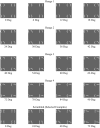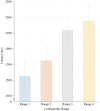How Configural Is the Configural Superiority Effect? A Neuroimaging Investigation of Emergent Features in Visual Cortex
- PMID: 28167924
- PMCID: PMC5253576
- DOI: 10.3389/fpsyg.2017.00032
How Configural Is the Configural Superiority Effect? A Neuroimaging Investigation of Emergent Features in Visual Cortex
Abstract
The perception of a visual stimulus is dependent not only upon local features, but also on the arrangement of those features. When stimulus features are perceptually well organized (e.g., symmetric or parallel), a global configuration with a high degree of salience emerges from the interactions between these features, often referred to as emergent features. Emergent features can be demonstrated in the Configural Superiority Effect (CSE): presenting a stimulus within an organized context relative to its presentation in a disarranged one results in better performance. Prior neuroimaging work on the perception of emergent features regards the CSE as an "all or none" phenomenon, focusing on the contrast between configural and non-configural stimuli. However, it is still not clear how emergent features are processed between these two endpoints. The current study examined the extent to which behavioral and neuroimaging markers of emergent features are responsive to the degree of configurality in visual displays. Subjects were tasked with reporting the anomalous quadrant in a visual search task while being scanned. Degree of configurality was manipulated by incrementally varying the rotational angle of low-level features within the stimulus arrays. Behaviorally, we observed faster response times with increasing levels of configurality. These behavioral changes were accompanied by increases in response magnitude across multiple visual areas in occipito-temporal cortex, primarily early visual cortex and object-selective cortex. Our findings suggest that the neural correlates of emergent features can be observed even in response to stimuli that are not fully configural, and demonstrate that configural information is already present at early stages of the visual hierarchy.
Keywords: configural; emergent features; fMRI; perception; perceptual organization; ventral visual pathway; vision; visual cortex.
Figures






Similar articles
-
The perceptual interaction of graphical attributes: configurality, stimulus homogeneity, and object integration.Percept Psychophys. 1990 Feb;47(2):157-68. doi: 10.3758/bf03205980. Percept Psychophys. 1990. PMID: 2304814
-
The effect of emergent features on judgments of quantity in configural and separable displays.J Exp Psychol Appl. 2008 Jun;14(2):85-100. doi: 10.1037/1076-898X.14.2.85. J Exp Psychol Appl. 2008. PMID: 18590366
-
Configural superiority for varying contrast levels.Atten Percept Psychophys. 2020 Jun;82(3):1355-1367. doi: 10.3758/s13414-019-01917-y. Atten Percept Psychophys. 2020. PMID: 31741319
-
Neural pathways for visual speech perception.Front Neurosci. 2014 Dec 1;8:386. doi: 10.3389/fnins.2014.00386. eCollection 2014. Front Neurosci. 2014. PMID: 25520611 Free PMC article. Review.
-
From orientations to objects: Configural processing in the ventral stream.J Vis. 2015;15(7):4. doi: 10.1167/15.7.4. J Vis. 2015. PMID: 26024513 Review.
Cited by
-
Encoding specificity instead of online integration of real-world spatial regularities for objects in working memory.J Vis. 2022 Aug 1;22(9):8. doi: 10.1167/jov.22.9.8. J Vis. 2022. PMID: 36040269 Free PMC article.
-
Gestalts at threshold could reveal Gestalts as predictions.Sci Rep. 2021 Sep 15;11(1):18308. doi: 10.1038/s41598-021-97878-0. Sci Rep. 2021. PMID: 34526565 Free PMC article.
-
Neural Signatures of the Configural Superiority Effect and Fundamental Emergent Features in Human Vision.Sci Rep. 2018 Sep 17;8(1):13954. doi: 10.1038/s41598-018-32289-2. Sci Rep. 2018. PMID: 30224676 Free PMC article.
-
Cognitive Structures of Space-Time.Front Psychol. 2020 Oct 21;11:527114. doi: 10.3389/fpsyg.2020.527114. eCollection 2020. Front Psychol. 2020. PMID: 33192768 Free PMC article.
References
-
- Bennett K. B., Flach J. M. (2011). Display and Interface Design: Subtle Science, Exact Art. Boca Raton, FL: CRC Press.
LinkOut - more resources
Full Text Sources
Other Literature Sources

